#sr ranganathan
Explore tagged Tumblr posts
Text


old men yaoi. no this isn't any fandom, these are prominent academics in my field (and the field adjacent). the two in the comic hated each other a lot but those are real quotes or paraphrases that they said about each other. i will not apologize
#tr schellenberg#hilary jenkinson#sr ranganathan#robert s taylor#academia#archival studies#library studies#information science#my art#i am insane.
275 notes
·
View notes
Note
Shiyali Ramamrita Ranganathan could never have predicted this...
As someone who is currently in library science school and taking classes on metadata and classification and why and how we categorize the kink taxonomy discussion is FACINATING
Organizational and classification systems are endless fractal nightmares… I love them so much <3
In a better world there would be a specific-ass tag for every specific-ass kink (I love and hate you controlled vocabulary) but also a truly brilliant combined hierarchical and non hierarchical relationship system for organizing and accessing the porn tags. The getty Art & Architecture Thesaurus but horny and not annoying
A man can dream… a man can dream.
i think even the most granular taxonomical system would not save us from the inevitability of semantic drift
#library things#kink talk#kink taxonomy hell#sorry for the niche memes#i did a report on the guy in library school so now he is my library science blorbo#sr ranganathan
102 notes
·
View notes
Text
Coral Morphology & Colouration
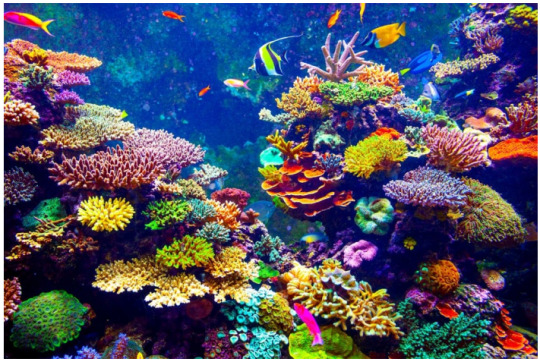
Credit: Gaby Pilson
In this blog, we will explore various shapes of corals and the factors determining coral morphology. We will also know how colourful corals acquire diverse colouration. Before getting to the main points, let's take a look at various beautiful corals below.
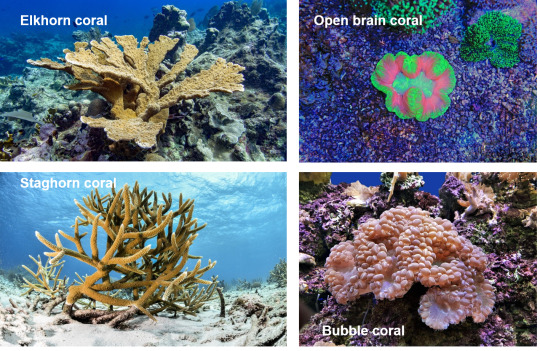
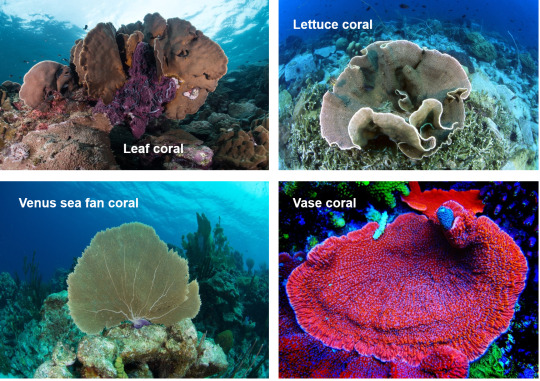
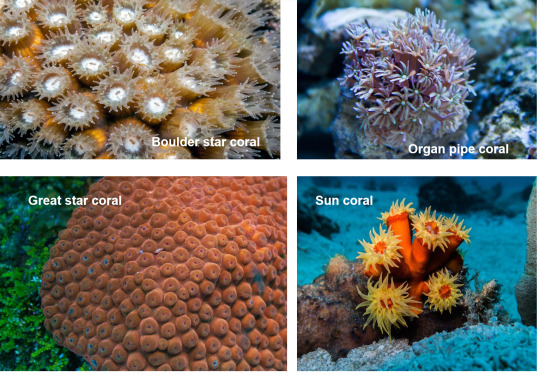
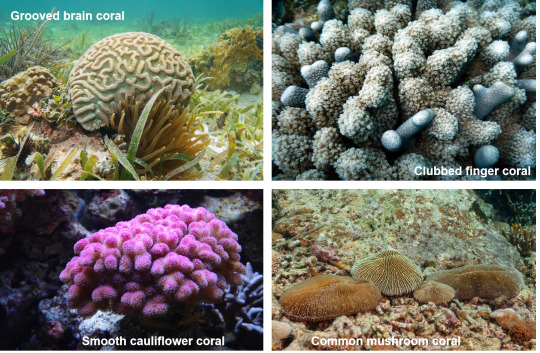
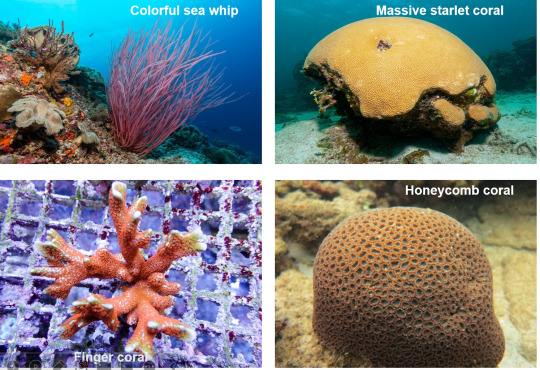

Credit: Gaby Pilson
Coral morphology
Within and among taxa, scleractinian corals vary in morphology, from the simple encrusting or hemispherical colonial shape to tree-like branching, bubble-like, finger-like or globular shapes (Zawada, Dornelas & Madin 2019).
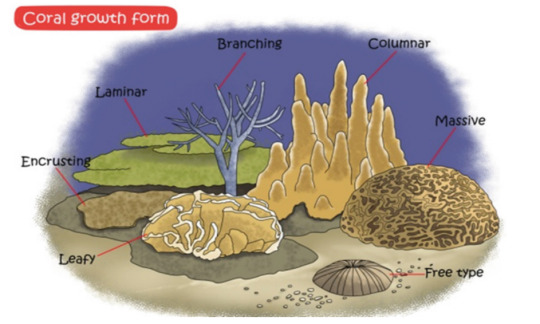
Credit: Liao, Xiao & Li
The variation and complexity in the morphology of corals can be affected by several factors, such as
environmental conditions (Zawada, Dornelas & Madin 2019)
biological process (Jackson 1979)
genetic constraints (Filatov et al. 2013)
partial mortality (Meesters, Wesseling & Bak 1996)
fragmentation of colony (Karlson 1986)
indeterminate growth (Sebens 1987)
The environmental conditions include free-flowing water for filter feeding and adequate sunlight for photosynthesis (Hoogenboom, Connolly & Anthony 2008; Kaandrop et al. 1996). Although most corals favour the mentioned environmental conditions, corals can also adapt to less optimal growing environments. Based on adaptability, various coral species' population density also differs in a particular environment.
For instance, platy and foliose corals are the dominant species in deeper water or shallow, sheltered, high-turbid and low-light areas (Riegl, Heine & Branch 1996; Hallock 2005). Other coral species also grow in such regions, but their population densities are relatively lower (Zapalski et al. 2021). These two corals are more adaptable to low light because the platy and foliose morphologies maximize the surface area to harvest light for photosynthesis (Anthony, Hoogenboom & Connolly 2005; Kahng et al. 2012).
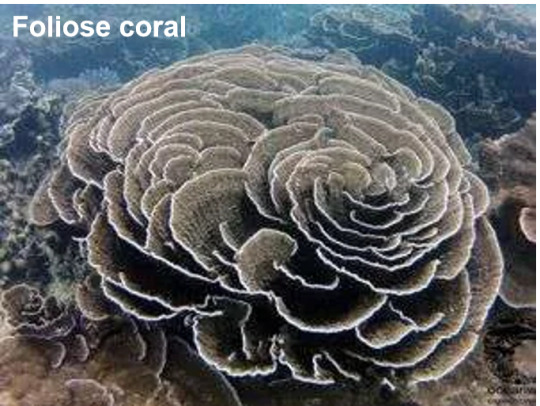
Credit: Khao Lak Explorer
Some corals, such as the staghorn and elkhorn corals, grow upwards to reduce and avoid competition for the benthic space (Jackson 1997). The upward growth allows these corals not to need to continuously occupy the benthic space to increase their standing biomass.

Credit: Gaby Pilson
Some corals, such as laminar and foliose corals, grow laterally on the benthos to diversify the risk, thereby reducing the colony's mortality (Jackson 1979).

Credit: Khao Lak Explorer (Foliose coral); Project Noah (Laminar coral)
Coral colouration
Corals are colourful. But how do corals acquire diverse colour patterns and intensities? Well, the coral colouration is determined by (Dove et al. 2006; Oswald et al. 2007):
endosymbionts
fluorescent proteins
The symbiotic dinoflagellates living in the coral cells give a brown colour to the surfaces of corals (Porter et al. 1984). Depending on the densities of the cells or photosynthetic pigments, the brown colour may get paler or darker (Porter et al. 1984).
The fluorescent proteins (FPs) in coral cells mainly refer to the green fluorescent protein-like proteins that can fluoresces under the visible or ultraviolet light to produce colouration in corals, such as the brilliant green, red and blue (Dove, Hoegh-Guldberg & Ranganathan 2001). FPs are suggested to be photo-protective (Salih et al. 2000) or photo-enhancing (Schlichter, Meier & Fricke 1994). In the photo-protective role, FPs can dissipate excess energy by scattering light and fluorescing to prevent photo-damage and photo-inhibition in coral symbionts in excessive sunlight (Salih et al. 2000). In the photo-enhancing role, FPs can absorb light with a shorter wavelength and re-emit it with a wavelength suitable for the endosymbiont of corals to carry out photosynthesis (Frade et al. 2008).
That's all for this blog. Hope you enjoy the read ^ ^
References
Anthony, KR, Hoogenboom, MO & Connolly, SR 2005, ‘Adaptive variation in coral geometry and the optimization of internal colony light climates’, Functional Ecology, vol. 19, pp.17-26.
Dove, SG, Hoegh-Guldberg, O & Ranganathan, S 2001, ‘Major colour patterns of reef-building corals are due to a family of GFP-like proteins’, Coral Reefs, vol. 19, pp.197-204.
Dove, S, Ortiz, JC, Enríquez, S, Fine, M, Fisher, P, Iglesias-Prieto, R, Thornhill, D & Hoegh-Guldberg, O 2006, ‘Response of holosymbiont pigments from the scleractinian coral Montipora monasteriata to short‐term heat stress’, Limnology and Oceanography, vol. 51, no. 2, pp.1149-1158.
Filatov, MV, Frade, PR, Bak, RP, Vermeij, MJ & Kaandorp, JA 2013, ‘Comparison between colony morphology and molecular phylogeny in the Caribbean scleractinian coral genus Madracis’, PLoS One, vol. 8, no. 8, p.e71287.
Frade, PR, Englebert, N, Faria, J, Visser, PM & Bak, RPM 2008, ‘Distribution and photobiology of Symbiodinium types in different light environments for three colour morphs of the coral Madracis pharensis: Is there more to it than total irradiance?’, Coral Reefs, vol. 27, pp.913-925.
Hallock, P 2005, ‘Global change and modern coral reefs: New opportunities to understand shallow-water carbonate depositional processes’, Sedimentary Geology, vol. 175, pp.19-33.
Hoogenboom, MO, Connolly, SR & Anthony, KR 2008, ‘Interactions between morphological and physiological plasticity optimize energy acquisition in corals’, Ecology, vol. 89, no. 4, pp.1144-1154.
Jackson, JBC 1979, ‘Morphological strategies of sessile animals’, in G Larwood & BR Rosen (eds), Biology and Systematic of Colonial Animals, Academic Press, Google ebooks, pp. 499-555.
Kaandorp, JA, Lowe, CP, Frenkel, D & Sloot, PM 1996, ‘Effect of nutrient diffusion and flow on coral morphology’, Physical Review Letters, vol. 77, no. 11, p.2328.
Kahng, SE, Hochberg, EJ, Apprill, A, Wagner, D, Luck, DG, Perez, D & Bidigare, RR 2012, ‘Efficient light harvesting in deep-water zooxanthellate corals’, Marine Ecology Progress Series, vol. 455, pp.65-77.
Karlson, RH 1986, ‘Disturbance, colonial fragmentation, and size-dependent life history variation in two coral reef cnidarians’, Marine Ecology Progress Series, vol. 28, pp.245-249.
Meesters, EH, Wesseling, I & Bak, RP 1996, ‘Partial mortality in three species of reef-building corals and the relation with colony morphology’, Bulletin of Marine Science, vol. 58, no. 3, pp.838-852.
Oswald, F, Schmitt, F, Leutenegger, A, Ivanchenko, S, D'Angelo, C, Salih, A, Maslakova, S, Bulina, M, Schirmbeck, R, Nienhaus, GU & Matz, MV 2007, ‘Contributions of host and symbiont pigments to the coloration of reef corals’, The FEBS Journal, vol. 274, no. 4, pp.1102-1122.
Porter, JW, Muscatine, L, Dubinsky, Z & Falkowski, PG 1984, ‘Primary production and photoadaptation in light-and shade-adapted colonies of the symbiotic coral, Stylophora pistillata’, Proceedings of the Royal Society of London. Series B. Biological Sciences, vol. 222, no. 1227, pp.161-180.
Riegl, B, Heine, C & Branch, GM 1996, ‘Function of funnel-shaped coral growth in a high-sedimentation environment’, Marine Ecology Progress Series, vol. 145, pp.87-93.
Salih, A, Larkum, A, Cox, G, Kühl, M & Hoegh-Guldberg, O 2000, ‘Fluorescent pigments in corals are photoprotective’, Nature, vol. 408, no. 6814, pp.850-853.
Schlichter, D, Meier, U & Fricke, HW, 1994 ‘Improvement of photosynthesis in zooxanthellate corals by autofluorescent chromatophores’, Oecologia, vol. 99, pp.124-131.
Sebens, KP 1987, ‘The ecology of indeterminate growth in animals’, Annual Review of Ecology and Systematics, vol. 18, pp.371-407.
Zapalski, MK, Baird, AH, Bridge, T, Jakubowicz, M & Daniell, J 2021, ‘Unusual shallow water Devonian coral community from Queensland and its recent analogues from the inshore Great Barrier Reef’, Coral Reefs, vol. 40, pp.417-431.
Zawada, KJ, Dornelas, M & Madin, JS 2019, ‘Quantifying coral morphology’, Coral Reefs, vol. 38, no. 6, pp.1281-1292.
Images or videos from external sources:
Gaby Pilson - https://outforia.com/types-of-coral/
Khao Lak Explorer - https://www.khaolakexplorer.com/coral-types/
Liao, Xiao & Li - https://link.springer.com/chapter/10.1007/978-94-024-1612-1_1
Project Noah - https://www.projectnoah.org/spottings/6319210
0 notes
Text
was he actually a pioneer in the field or was he actually just a control freak
#@sr ranganathan#u r not the boss of bookshelves#stop telling librarians how to build a table#go touch some grass babe
3 notes
·
View notes
Text
Librarians ' day celebrated at Indian Military Academy
Librarians ‘ day celebrated at Indian Military Academy
Dehradun : The Central Government Library As . sociation ( CGLA ) organised librarians ‘ day on the occasion of Padmashri Dr SR Ranganathan’s 130th birth anniversary at the Indian Military A cademy ( IMA ) on Friday . The event was inaugu rated by Brig Harish Garg , head of academic de partment , IMA . day celebrated at Indian Military Ramesh Goyal , president of CGLA , spoke about the…

View On WordPress
0 notes
Text
Dharmaprabhu Official Trailer | Yogi Babu | Muthukumaran | Sri Vaari Film | New Tamil Trailer 2019
#Dharmaprabhu #Official #Trailer | #YogiBabu | #Muthukumaran | #Sr VaariFilm | New Tamil Trailer 2019 #ut #universaltamil #lka #srilanka
Dharmaprabhu Official Trailer | Yogi Babu | Muthukumaran | Sri Vaari Film | New Tamil Trailer 2019
Watch Dharmaprabhu Official Trailer 2019.
Dharma Prabhu Trailer
#dharmaprabhu #yogibabu
Production : Sri Vaari Film (P Ranganathan)
Direction : Muthukumaran
Starring : Yogi Babu, Ramesh Thilak, Azhagam Perumal, Radha Ravi, Rekha,…
View On WordPress
0 notes
Text
I mean I'm not saying I'm gonna
but like
I've got 24 hours to get ny proposal in
no other ideas
and as far as I can tell no one else has ever done a comprehensive examination of how SR Ranganathan's 5 laws of library science can be applied to fanfiction
might just fuck around and write my masters dissertation about fanfiction
13 notes
·
View notes